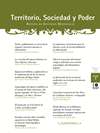Abstract
Resumen: El artículo aborda un análisis de los procesos de constitución territorial acontecidos en el oriente asturiano durante los siglos altomedievales. Prima un acercamiento político y socioeconómico desde el punto de vista heurístico e interdisciplinar desde el punto de vista metodológico, conjuntando fuentes textuales y arqueológicas. Nuestra intención es caracterizar el intenso dinamismo que viven estos territorios, con interrogantes difíciles de responder, así como su papel en la imposición final de una rearticulación del espacio a través de las estructuras de dominio feudales. En último lugar, el análisis de los territorios orientales da paso a un breve retrato de los repartos de poder en este cuadrante, centrado en la historia de una familia con singular protagonismo en el régimen de tenencias de los siglos xii y xiii.
Palabras clave: reino de Asturias, Antigüedad Tardía, territorios políticos, esferas de poder, topografías de poder, tenencias, dominios señoriales, feudalismo, jurisdicciones, aristocracia.
Summary: This article approaches an analysis of the processes of territorial constitution that ocurred in Eastern Asturias during the Early Middle Age. Based on both textual and archeological sources, our approach is political and socioeconomic from a heuristic point of view, and interdisciplinar from a methodological point of view. Our purpose is to characterize the intense dynamism experienced in these territories as well as its role in their final reshapement by means of structures of feudal dominion. Finally, the analysis of the Eastern territories is followed by a brief portrait of the power distribution in this area, with special attention to the history of a family which extraordinary protagonism in the system of tenencias during the xii and xiii centuries.
Keywords: Kingdom of Asturias, Late Antiquity, political territories, spheres of power, topographies of power, central sites, tenencias, royal residence, feudal dominions, jurisdictions, aristocracy.
Abstract: The formation of a net of settlements in the Early Middle Age and the progressive introduction of feudal dominion mechanism cannot be understood withouth the parallel genesis of a political superstructure. As several means of production, land and population control are developed and gradually refined along the xi and xii centuries, political demarcations experience a slow process of normalization, wich constitutes the closure of the dominion system imposed by aristocracy.
Our proposals have been applied to the lands of Eastern Asturias. This is the area where the first center of power of the kingdom of Asturias originated after the muslim invasion of 711 A. D.: the royal settlement of Cangas de Onis.
We have discriminated in this zone between facets of political action or experimentation and facets of political institutionalization. Considered from a spatial perspective, the facets of political action or experimentation give rise to spheres of power linked to geographical entities (particulary, valleys and fluvial arteries), and to topographies of power (villae, palatia, castra, monasteria...). These central sites that function as organizing axes are characteristic in societies lacking a central political structure. They establish a series of strategies politically motivated social relations: internal pacts within the elite, holding of assemblies, family associations through marital contracts, hierarchy nets between central sites. The spheres of power originated upon the dissolution of the Roman Empire´s political and administrative organization in the iii and iv centuries, and the subsequent creation of territories linked to the local aristocracy. The areas can be based in fundi or ancient sites of power as Maleagio, Columca and Cangas de Onis. Here, during 722 A. D. an aristocrat named Pelagius was elected princeps in a local nobility assembly. He was the first king of Asturias.
The facets of political institutionalization attempt to homogenize the above mentioned map by means of juridical and institutional regulations agreed by the monarch and the nobility. The result is precise: the making of the king’s ministerium and an administratio for the kingdom. In Eastern Asturias, we observe an intention to structure the political organization of these territories since the ix century. The new proposal contradict the old theory that postpone the territorial configuration in Asturias even the xi century. It is during the reigns of Ordoño I (850-866) and Alfonso III (866-910) when documentation reveals the first clear mentions of boundary lines. This is the origin of Primorias macroterritory. Nevertheless, regulatory efforts still have to deal with fragmented map of power. The consequence is a precarious consistence built on considerable irregularities: other territories named territoria, commissa or mandationes (Kangas, Maleagio), along with more difuse frames of feudal and political experimentation (central sites, such as castra, monasteria and ecclesiae), as well as pheripherical areas progressively threatened by the aristocracy. Likewise, the configuration of the first political territories usually takes place in spheres of strong aristocratic presence or royal settlements. Nobility itself shows to be powerful enough to acquire important lots of land under its control during the x century. This is the case of the counts Piniolo and Aldonza, who interchange their castles in Eastern Asturias with the king Bermudo III in 1032. Upon the arrival to the castellano-leones throne of the navarra dinasty after the victory of Fernando I in Tamaron (1037 A. D.) the progress of a territorial system accelerates. A new terminology for demarcations (tenencias, alfoces) and for royal representatives (tenentes, dominantes) is introduced. This process, which runs parallel to the development of the feudal society, reveals its purest form in the xii century. Inmunity spaces or enclosures bestowed on the main monasteries (Santa María de Valdediós, Santa María de Covadonga) and church dominions (the bishop´s lordship of San Salvador de Oviedo) are now clearly defined. Amid this ambiguous confrontation between the monarchy and the nobility —whose critical moment occurs during the rebellion of count Gonzalo Pelaez (1132-1137)— the sovereigns will tend to grant political posts on second-ranked noblemen. Among them, Rodrigo and Gutierre Sebastianiz, who were elevated to high positions by Alfonso VII during the rebellion of Gonzalo Pelaez and managed to keep these privileges for on their descendents throughout the xii and xiii centuries.

